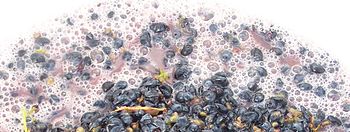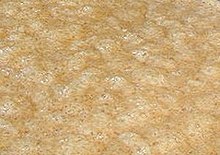發酵 (葡萄酒)

發酵是葡萄酒釀製的一個重要過程,通過這一過程可以讓葡萄汁轉變為酒精飲料。這一過程中酵母和葡萄酒裏的糖相互作用產生乙醇和二氧化碳。未發酵時葡萄汁中的氧氣含量和溫度等都是需要注意的事項,而且發酵過程中可能會有發酵停滯和數種葡萄酒變質現象發生。發酵葡萄酒的容器可以是不鏽鋼桶、敞開的木桶、橡木桶和葡萄酒瓶中。[1][2]
歷史
[编辑]發酵這一現象可能很久以前就被人類觀察到了。[3]最早在葡萄酒釀製中使用“發酵”一詞是用來指葡萄酒中發生厭氧反應的酵母和糖產生二氧化碳,使得葡萄酒起泡的現象。拉丁語“fervere”的字面意思就是“煮”。在19世紀中期,路易·巴斯德記下了酵母與發酵過程的關係:酵母作為催化劑和中介物使得糖通過一系列反應產生酒精。20世紀早期古斯塔夫·恩伯登、奧托·邁爾霍夫和Jakub Karol Parnas關於糖酵解的研究進一步解釋了這一化學反應。[4]
酵母發酵過程
[编辑]在葡萄酒釀製過程中,需區別外界酵母(ambient yeast,通常存在於酒窖、葡萄園和葡萄自身上)和人工培育的酵母(cultured yeast)。最常見的野生外界酵母包括假絲酵母屬、毕赤酵母属和接合酵母属等。這些酵母可產生高質量的美味葡萄酒,但是不容易控制甚至可能會導致葡萄酒變質。有少量的酵母菌、乳酸菌和乙酸菌菌落自然生活在葡萄的表面,[5]傳統的釀酒人(特別是在歐洲)傾向使用外界酵母,而另外一大部份人則傾向使用易控制的人工培育的酵母。最常見的人工培育的酵母是釀酒酵母,它有數百種不同的菌株可以用來影響葡萄酒的釀造,這是同一種葡萄為何可以釀出不同葡萄酒的原因之一。[6]也有其他的酵母被用來為葡萄酒添加風味。[7]
要令葡萄酒中的酵母發生反應,需要持續提供碳、氮、硫、磷和各種維生素及礦物質。這些物質本身就存在於未發酵的葡萄汁中,但通過加入營養鹽,可以使反應更完美。氧也是必要的元素之一,但是因為氧化反應可能會導致葡萄酒變質,故其量需要極小心地控制。[8]

在未發酵的葡萄汁中加入活躍的酵母時,磷酸鹽和一些六碳糖分子開始發生重排反應。在這一過程中,羧基碳原子以二氧化碳的形式的釋放出來,幷發生一些反應形成乙醛。因為缺少氧氣,乙醛最終轉變成乙醇,並有一小部份轉變成乙酸,過量的乙酸會導致葡萄酒變質。最後酵母的使命完成,沉澱到葡萄酒底部成為殘渣。[9]
其他化合物
[编辑]
一些酵母菌株可以產生揮發性的硫醇,這種物質是一些葡萄酒水果香氣的來源,例如白蘇維濃中的醋栗香。酒香酵母屬酵母也會令一些葡萄酒(例如勃艮第葡萄酒和黑比諾釀製的葡萄酒)產生香氣。[10]
注意事項
[编辑]
在葡萄酒發酵過程中,有數個因素需要注意。例如乙醇生產導致的含糖量變化、酵母菌株的使用和發酵溫度。[11]
發酵本身產生的殘餘熱會使得葡萄酒偏離理想溫度。在生產一些白葡萄酒時,雖然要令這些葡萄酒產生其他風味需要更高的溫度,釀酒師卻會選擇在較低的64-68 °F(18-20 °C)下發酵酒。一些紅酒則會選擇更高的85 °F(29 °C)。過高溫度會導致葡萄酒變質,一些酵母也可能會停止活動。[9]爲了控制發酵產生的熱,釀酒師會選擇合適的容器或者使用降溫器材。例如在酒桶上放置冰塊以及使用酒桶內置降溫環。[12]一些希望葡萄酒中有殘留糖分(例如一瓶干葡萄酒)的釀酒師會提前降低葡萄汁的溫度,或者再加入一定量的酒精(例如白蘭地)以殺死酵母,釀成加強葡萄酒。[9]
發酵時產生的乙醇是許多不溶於水的化合物的助溶劑,例如一些葡萄皮上的物質,從而通過反應令就酒產生各種色澤和香氣。作為細菌生長的抑製劑,乙醇可以保證葡萄酒多年不壞。[13]
其他類型的發酵
[编辑]瓶中發酵
[编辑]瓶中發酵是氣泡酒生產的一種方法,起源於香檳地區。一批釀造的葡萄酒在發酵後裝瓶,並進行二次發酵,形成再發酵液(liqueur de tirage)。第二次發酵產生的二氧化碳氣泡就是氣泡酒名稱的起源。[14]
二氧化碳浸漬法
[编辑]二氧化碳浸漬法是令葡萄本身發酵而不是添加酵母粉,薄酒萊葡萄酒採用的就是這種方法。[15]不像正常的發酵那樣通酵母使糖轉變為酒精,這種分方法是利用葡萄中的酶來發生作用。這種方法生產的酒通常會比較溫和、有水果香氣。[16]
蘋果酸發酵
[编辑]蘋果酸發酵中細菌取代酵母的地位,將蘋果酸轉變為乳酸。這種方法會減少葡萄酒的辛辣感,很多情況下可與酵母發酵法互相替代。[17]
參見
[编辑]- 食品發酵
- 共發酵
- 糖
參考資料
[编辑]- ^ J. Robinson (ed) "The Oxford Companion to Wine" Third Edition pg 267-269 Oxford University Press 2006 ISBN 0-19-860990-6
- ^ J. Robinson Jancis Robinson's Wine Course Third Edition pg 74-84 Abbeville Press 2003 ISBN 0-7892-0883-0
- ^ H. Johnson Vintage: The Story of Wine pg 16 Simon and Schuster 1989 ISBN 0-671-68702-6
- ^ J. Robinson (ed) "The Oxford Companion to Wine" Third Edition pg 267 Oxford University Press 2006 ISBN 0-19-860990-6
- ^ Gemma Beltran, Maria Jesus Torija, Maite Novo, Noemi Ferrer, Montserrat Poblet, Jose M. Guillamon, Nicholas Rozes, and Albert Mas. “Analysis of Yeast Populations During Alcohol Fermentation: A Six Year Follow-up Study”. pg3-4 Systematic and Applied Microbiology 25.2 (2002): 287-293. Web. 19 Aug. 2012.
- ^ J. Robinson (ed) "The Oxford Companion to Wine" Third Edition pg 778-779 Oxford University Press 2006 ISBN 0-19-860990-6
- ^ Gemma Beltran, Maria Jesus Torija, Maite Novo, Noemi Ferrer, Montserrat Poblet, Jose M. Guillamon, Nicholas Rozes, and Albert Mas. “Analysis of Yeast Populations During Alcohol Fermentation: A Six Year Follow-up Study”. Systematic and Applied Microbiology 25.2 (2002): 287-293. Web. 19 Aug. 2012.
- ^ J. Robinson (ed) "The Oxford Companion to Wine" Third Edition pg 779 Oxford University Press 2006 ISBN 0-19-860990-6
- ^ 9.0 9.1 9.2 J. Robinson (ed) "The Oxford Companion to Wine" Third Edition pg 268 Oxford University Press 2006 ISBN 0-19-860990-6
- ^ J. Robinson (ed) "The Oxford Companion to Wine" Third Edition pg 780 Oxford University Press 2006 ISBN 0-19-860990-6
- ^ Jackson, Ronald S. Wine Science Principles and Applications. pg276 San Diego, California: Academic Press, 2008. Print.
- ^ J. Robinson Jancis Robinson's Wine Course Third Edition pg 82 Abbeville Press 2003 ISBN 0-7892-0883-0
- ^ Jackson, Ronald S. Wine Science Principles and Applications. pg 276 San Diego, California: Academic Press, 2008. Print.
- ^ K. MacNeil The Wine Bible pg 168-169 Workman Publishing 2001 ISBN 1-56305-434-5
- ^ K. MacNeil The Wine Bible pg 33-34 Workman Publishing 2001 ISBN 1-56305-434-5
- ^ D. Bird "Understanding Wine Technology" pg 89-92 DBQA Publishing 2005 ISBN 1-891267-91-4
- ^ K. MacNeil The Wine Bible pg 35 Workman Publishing 2001 ISBN 1-56305-434-5
| |||||||||||||||||||||||||||||||||||||
| ||||||||||||||||||||||||||||||||||||
Text is available under the CC BY-SA 4.0 license; additional terms may apply.
Images, videos and audio are available under their respective licenses.
